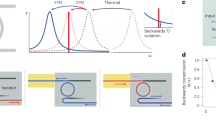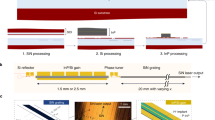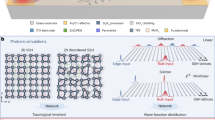Abstract
Rapid progress in photonics has led to an explosion of integrated devices that promise to deliver the same performance as table-top technology at the nanoscale, heralding the next generation of optical communications, sensing and metrology, and quantum technologies. However, the challenge of co-integrating the multiple components of high-performance laser systems has left application of these nanoscale devices thwarted by bulky laser sources that are orders of magnitude larger than the devices themselves. Here we show that the two main components for high-performance lasers—noise reduction and isolation—can be sourced simultaneously from a single, passive, CMOS-compatible nanophotonic device, eliminating the need to combine incompatible technologies. To realize this, we take advantage of both the long photon lifetime and the non-reciprocal Kerr nonlinearity of a high-quality-factor silicon nitride ring resonator to self-injection lock a semiconductor laser chip while also providing isolation. We also identify a previously unappreciated power regime limitation of current on-chip laser architectures, which our system overcomes. Using our device, which we term a unified laser stabilizer, we demonstrate an on-chip integrated laser system with built-in isolation and noise reduction that operates with turnkey reliability. This approach departs from efforts to directly miniaturize and integrate traditional laser system components and serves to bridge the gap to fully integrated optical technologies.
This is a preview of subscription content, access via your institution
Access options
Access Nature and 54 other Nature Portfolio journals
Get Nature+, our best-value online-access subscription
27,99 € / 30 days
cancel any time
Subscribe to this journal
Receive 12 print issues and online access
209,00 € per year
only 17,42 € per issue
Buy this article
- Purchase on SpringerLink
- Instant access to full article PDF
Prices may be subject to local taxes which are calculated during checkout




Similar content being viewed by others
Data availability
All data are available from the corresponding authors on reasonable request.
References
Kikuchi, K. Fundamentals of coherent optical fiber communications. J. Lightwave Technol. 34, 157–179 (2015).
McGrew, W. et al. Atomic clock performance enabling geodesy below the centimetre level. Nature 564, 87–90 (2018).
Daley, A. J. et al. Practical quantum advantage in quantum simulation. Nature 607, 667–676 (2022).
Yang, K. Y. et al. Multi-dimensional data transmission using inverse-designed silicon photonics and microcombs. Nat. Commun. 13, 7862 (2022).
Rizzo, A. et al. Massively scalable Kerr comb-driven silicon photonic link. Nat. Photon. 17, 781–790 (2023).
Feldmann, J. et al. Parallel convolutional processing using an integrated photonic tensor core. Nature 589, 52–58 (2021).
Ashtiani, F., Geers, A. J. & Aflatouni, F. An on-chip photonic deep neural network for image classification. Nature 606, 501–506 (2022).
Pai, S. et al. Experimentally realized in situ backpropagation for deep learning in photonic neural networks. Science 380, 398–404 (2023).
Trocha, P. et al. Ultrafast optical ranging using microresonator soliton frequency combs. Science 359, 887–891 (2018).
Rogers, C. et al. A universal 3D imaging sensor on a silicon photonics platform. Nature 590, 256–261 (2021).
Li, B., Lin, Q. & Li, M. Frequency–angular resolving lidar using chip-scale acousto-optic beam steering. Nature 620, 316–322 (2023).
Wang, J., Sciarrino, F., Laing, A. & Thompson, M. G. Integrated photonic quantum technologies. Nat. Photon. 14, 273–284 (2020).
Madsen, L. S. et al. Quantum computational advantage with a programmable photonic processor. Nature 606, 75–81 (2022).
Zheng, Y. et al. Multichip multidimensional quantum networks with entanglement retrievability. Science 381, 221–226 (2023).
Zhou, Z. et al. Prospects and applications of on-chip lasers. eLight 3, 1 (2023).
Liu, A. Y., Komljenovic, T., Davenport, M. L., Gossard, A. C. & Bowers, J. E. Reflection sensitivity of 1.3 μm quantum dot lasers epitaxially grown on silicon. Opt. Express 25, 9535 (2017).
Dong, B. et al. Dynamic performance and reflection sensitivity of quantum dot distributed feedback lasers with large optical mismatch. Photon. Res. 9, 1550 (2021).
Matsui, Y. et al. Low-chirp isolator-free 65-GHz-bandwidth directly modulated lasers. Nat. Photon. 15, 59–63 (2021).
Tkach, R. & Chraplyvy, A. Regimes of feedback effects in 1.5-μm distributed feedback lasers. J. Lightwave Technol. 4, 1655–1661 (1986).
Jin, W. et al. Hertz-linewidth semiconductor lasers using CMOS-ready ultra-high-Q microresonators. Nat. Photon. 15, 346–353 (2021).
Guo, J. et al. Chip-based laser with 1-hertz integrated linewidth. Sci. Adv. 8, eabp9006 (2022).
Herrmann, J. F. et al. Mirror symmetric on-chip frequency circulation of light. Nat. Photon. 16, 603–608 (2022).
Yu, M. et al. Integrated electro-optic isolator on thin-film lithium niobate. Nat. Photon. 17, 666–671 (2023).
Tian, H. et al. Magnetic-free silicon nitride integrated optical isolator. Nat. Photon. 15, 828–836 (2021).
Del Bino, L., Silver, J. M., Stebbings, S. L. & Del’Haye, P. Symmetry breaking of counter-propagating light in a nonlinear resonator. Sci. Rep. 7, 43142 (2017).
Del Bino, L. et al. Microresonator isolators and circulators based on the intrinsic nonreciprocity of the Kerr effect. Optica 5, 279–282 (2018).
White, A. D. et al. Integrated passive nonlinear optical isolators. Nat. Photon. 17, 143–149 (2023).
Schawlow, A. L. & Townes, C. H. Infrared and optical masers. Phys. Rev. 112, 1940 (1958).
Li, B. et al. Reaching fiber-laser coherence in integrated photonics. Opt. Lett. 46, 5201–5204 (2021).
Xiang, C. et al. High-performance lasers for fully integrated silicon nitride photonics. Nat. Commun. 12, 6650 (2021).
Voloshin, A. S. et al. Dynamics of soliton self-injection locking in optical microresonators. Nat. Commun. 12, 235 (2021).
Lihachev, G. et al. Platicon microcomb generation using laser self-injection locking. Nat. Commun. 13, 1771 (2022).
Xiang, C. et al. 3D integration enables ultralow-noise isolator-free lasers in silicon photonics. Nature 620, 78–85 (2023).
Shim, E. et al. Tunable single-mode chip-scale mid-infrared laser. Commun. Phys. 4, 268 (2021).
Corato-Zanarella, M. et al. Widely tunable and narrow-linewidth chip-scale lasers from near-ultraviolet to near-infrared wavelengths. Nat. Photon. 17, 157 (2023).
Lihachev, G. et al. Low-noise frequency-agile photonic integrated lasers for coherent ranging. Nat. Commun. 13, 3522 (2022).
Snigirev, V. et al. Ultrafast tunable lasers using lithium niobate integrated photonics. Nature 615, 411–417 (2023).
Li, B. et al. High-coherence hybrid-integrated 780 nm source by self-injection-locked second-harmonic generation in a high-Q silicon-nitride resonator. Optica 10, 1241 (2023).
Ling, J. et al. Self-injection locked frequency conversion laser. Laser Photon. Rev. 17, 2200663 (2023).
Clementi, M. et al. A chip-scale second-harmonic source via self-injection-locked all-optical poling. Light Sci. Appl. 12, 296 (2023).
Kondratiev, N. et al. Self-injection locking of a laser diode to a high-Q WGM microresonator. Opt. Express 25, 28167 (2017).
Liu, J. et al. High-yield, wafer-scale fabrication of ultralow-loss, dispersion-engineered silicon nitride photonic circuits. Nat. Commun. 12, 2236 (2021).
Yuan, Z. et al. Correlated self-heterodyne method for ultra-low-noise laser linewidth measurements. Opt. Express 30, 25147–25161 (2022).
Shen, B. et al. Integrated turnkey soliton microcombs. Nature 582, 365 (2020).
Kondratiev, N. M. & Gorodetsky, M. L. Thermorefractive noise in whispering gallery mode microresonators: analytical results and numerical simulation. Phys. Lett. A 382, 2265–2268 (2018).
Huang, G. et al. Thermorefractive noise in silicon-nitride microresonators. Phys. Rev. A 99, 061801 (2019).
Acknowledgements
A.W. acknowledges the Herb and Jane Dwight Stanford Graduate Fellowship (SGF) and the NTT Research Fellowship. G.H.A. acknowledges support from STMicroelectronics Stanford Graduate Fellowship (SGF) and Kwanjeong Educational Foundation. Authors from Stanford University and UCSB acknowledge funding support from DARPA under the LUMOS programme. Authors from University of Washington acknowledge funding support from NSF under NSF-QII-TAQS-1936100. Part of this work was performed at the Stanford Nano Shared Facilities (SNSF)/Stanford Nanofabrication Facility (SNF), supported by the National Science Foundation under award ECCS-2026822.
Author information
Authors and Affiliations
Contributions
A.D.W., G.H.A., and K.V.G. conceived of the project. A.D.W., G.H.A., R.L., and K.V.G. performed the experiments. G.H.A. developed the silicon-nitride fabrication process and fabricated the devices with assistance from A.S. and A.M. J.G., T.J.M., L.C. and J.E.B. provided the semiconductor laser chip and experimental guidance. J.V. supervised the project. All authors contributed to data analysis and writing of the paper.
Corresponding authors
Ethics declarations
Competing interests
A.D.W., G.H.A., K.V.G. and J.V. have filed a patent application for the ULS laser architecture (PCT/US2023/032287). The other authors declare no competing interests.
Peer review
Peer review information
Nature Photonics thanks Pascal Del’Haye and the other, anonymous, reviewer(s) for their contribution to the peer review of this work.
Additional information
Publisher’s note Springer Nature remains neutral with regard to jurisdictional claims in published maps and institutional affiliations.
Supplementary information
Rights and permissions
Springer Nature or its licensor (e.g. a society or other partner) holds exclusive rights to this article under a publishing agreement with the author(s) or other rightsholder(s); author self-archiving of the accepted manuscript version of this article is solely governed by the terms of such publishing agreement and applicable law.
About this article
Cite this article
White, A.D., Ahn, G.H., Luhtaru, R. et al. Unified laser stabilization and isolation on a silicon chip. Nat. Photon. 18, 1305–1311 (2024). https://doi.org/10.1038/s41566-024-01539-3
Received:
Accepted:
Published:
Issue Date:
DOI: https://doi.org/10.1038/s41566-024-01539-3
This article is cited by
-
Two in one
Nature Photonics (2024)



